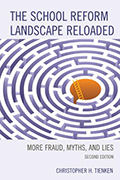Sound the alarm bells! The results from the international PISA test are coming! The public education sky will fall once again in December 2016 with the release of the results from the 2015 Programme for International Student Assessment (PISA). As usual, U.S. students will rank around the middle of the pack of the 65+ participating countries and cities in the areas of reading, math, or science.
As if on cue, some policy makers and education pundits will sound the alarms of the pending collapse of U.S. global competitiveness and national security. The hysteria will be followed shortly thereafter by calls for more standardized programs and corporatization of public schools so that U.S. students can once again claim their spot at the top of the rankings.
The point of this scenario is not that U.S. students do not rank higher on international tests. U.S. students have never ranked at the top of any international test of academic skills and knowledge since the inception of international testing in 1964. The real issue is that those alarmed by the PISA results fail to realize that rankings on international tests simply do not matter. As colleagues and I have documented on numerous occasions, rankings on international tests do not relate to international indicators of economic strength, global competitiveness, creativity, innovation, entrepreneurship, or any other economic indicators that reflect a strong economy (e.g., Tienken, 2008; Tienken & Mullen, 2014).
However, the touted importance of low U.S. rankings on international tests, and the ready-made solutions based on standardization of curricula expectations, teaching methods, and student outputs, do not stand up to scrutiny. In this brief post I argue, with a sample of what I believe are meaningful indicators of long-term education output, that the United States is one of the most economically competitive countries on the planet (Tienken, 2017). A more comprehensive discussion of international testing and U.S. global competitiveness can be found in chapters 2 & 3 of my book Defying Standardization: Creating Curriculum for an Uncertain Future.
The high-quality education outputs that help drive an innovation economy might not present themselves immediately or in ways that can be measured efficiently with an international standardized test. I submit that the education output that the PISA alarmists and proponents of standardization claim the United States lacks—the type of innovative and creative output they say will secure a globally competitive future for the U.S. economy—must be measured in the longer term, not the short-term, and certainly not by the primitive means of standardized testing.
A Global View of Global Competitiveness
The World Economic Forum (WEF), in its annual Global Competitiveness Report, consistently ranks the United States as one of the most competitive economies in the world (Schwab, 2015). The United States has ranked in the top 3 of the more than 130 world economies included in the annual WEF rankings for 12 of the 16 years from 1999 to 2015 (Schwab, 2015). No other country has achieved that consistent level of economic strength.
The International Institute for Management Development (IMD) also produces an annual ranking of global competitiveness for up to 61 economies. In the World Competitiveness Yearbook for 2015, IMD researchers ranked the U.S. economy first in the world during 19 out of the last 20 years, from 1996 to 2015 (IMD, 2015). WEF and IMD represent two influential international organizations that research and monitor global competitiveness as it relates to an innovation economy. Their rankings provide insights into a country’s macroeconomic strength. But there are other indicators that provide even more concrete information about the influence of education’s longer term outcomes such as creativity, innovation, and entrepreneurship.
Top of the Scientific Mountain
Some indicators of high-quality and innovative science are the numbers of scientific papers produced by a country overall and in specific fields such as physics and chemistry. In my opinion, the most comprehensive indicator of overall scientific output in terms of research and publications is the Top 20 Countries in All Fields, 2001–August 31, 2011, data released by Thomson Reuters (2011b). In this 10-year report, the United States ranked first with 3,049,662 scientific publications, followed by the People’s Republic of China in a distant second with 836,255, and Germany with 784,316.
The rankings for the scientific papers reported from the Top 20 Countries in Physics, 1997–2007, were similar to those for the scientific papers in all fields. The United States was first with 218,045 papers, Japan was second with 117,017, and Germany was third with 104,592 publications. The People’s Republic of China was fourth with 86,679 (Thomson Reuters, 2008a).
The United States is also home to most of the top chemists in the world. As of 2010, the most recent figures available, 18 of the top 20 chemists were based in the United States (Thomson Reuters, 2011a). Moreover, the majority of the top 100 chemists were based in the United States (Thomson Reuters, 2011a).
Mathematical “Failure”
Given the terrible rankings of U.S. students on international tests of mathematics, it would be impossible for the United States to dominate the world in high-quality mathematics research publications and citations, wouldn’t it? Nope – the United States ranks number one in the world for mathematics papers, citations, and citations per paper, with 65,830, 268,096, and 4.07, respectively (Thomson Reuters, 2008b). The second- and third-place countries, France and Germany, are not even close in these achievements. The combined output for France and Germany does not match that of the United States.
Creativity, Innovation, and Entrepreneurship
The Martin Prosperity Institute published the newest version of the Global Creativity Index (GCI) in 2015 (Florida, Mellander, & King). The GCI provided rankings for 139 of the world’s countries, including all the major industrialized countries and 19 members of the G20 group of nations—the world’s largest national economies (The European Union group of economies is the 20th member of the G20 but it is not ranked on international tests). The United States ranked 2nd in overall global creativity in 2015 behind Australia, Japan 24th, South Korea 31st, and China was 62nd.
The relationship between rankings by the GCI and the WEF is strong and positive at .75 with 1.00 being a perfect correlation. The GCI also relates positively to overall gross domestic product, another indicator of economic strength (Florida et al., 2015, p. 25). The PISA results do not correlate to any of those indicators for the G20 nations (Tienken & Mullen, 2014; Tienken & Tramaglini, 2017).
The Global Innovation Index (GII) is a multi-factor index that provides rankings on the innovative output and capacity of 139countries (Dutta, Lanvin, & Wunsch-Vincent, 2015). The index includes rankings for all the industrialized countries and G20 nations. The United States ranked 5th with a score of 60.10. The United States ranked first in the world on the sub-metric of innovation quality. The innovation quality ranking on the GII corresponds to the U.S. leadership in the area of innovation patents and overall scientific output (Tienken, 2017) and confirms that the United States brings to fruition some of the highest quality innovations in the world.
The Global Entrepreneurship Index (GEI) provides measures of entrepreneurial activities for 121 countries (Acs, Szerb, & Autio, 2015). Results are reported on a scale of 0-100 with 100 representing the country with the most entrepreneurial activities. The U.S. ranked first in the world out of 130 countries in overall entrepreneurship on the 2015 index, as it did on the 2014 index. Canada, Australia, the U.K, and Sweden rounded out the top five. The Republic of Korea ranked 28th with a score of 54.10, Japan ranked 33rd, Italy was 49th, China was 61st with a score of 36.40, and Russia ranked 70th.
Long-Term Outputs
The target populations for the GCI, GII, and GEI were mostly adults aged 25 to 35. In some cases the GEI used data from national and international indices that included people 18–65 years of age, but the inclusion of people less than 25 years old was not statistically significant. Similar to the age ranges for writers of scientific research and the world’s top scientists, the age ranges for the GCI, GII, and GEI are important to note because the overwhelming majority of people involved in the data collection processes for the indices cited attended school at times when it was unstandardized, or at least at times when schools had much less standardization of curriculum expectations and outputs.
The students in the age cohorts represented by the data included in the indices on creativity, innovation, and entrepreneurship all ranked low on every international test administered, yet their age cohorts dominate the world in long-term education output as measured through scientific production, economic indicators, creativity, innovation, and entrepreneurship. PISA results do not predict global competitiveness. Don’t believe the hype.
References
Ács, Z. J., Szerb, L., & Autio, E. (2015). The global entrepreneurship index 2015. Retrieved from The Global Entrepreneurship and Development Institute website: http://thegedi.org/product/2015-global-entrepreneurship-index
Dutta, S., Lanvin, B., & Wunsch-Vincent, S. (Eds.). (2015). The global innovation index 2015: Effective innovation policies for development. Geneva, Switzerland: Cornell University, INSEAD, & WIPO. Retrieved from https://www.globalinnovationindex.org/userfiles/file/reportpdf/gii-full-report-2015-v6.pdf
Florida, R., Mellander, C., & King, K. (2015). The global creativity index 2015. Retrieved from Martin Prosperity Institute website: http://martinprosperity.org/media/Global-Creativity-Index-2015.pdf
International Institute for Management Development. (2015, May 27). IMD releases its 2015 world competitiveness ranking [Press release]. Retrieved from http://www.imd.org/news/IMD-releases-its-2015-World-Competitiveness-Ranking.cfm
Schwab, K. (Ed.). (2015). The global competitiveness report 2015–2016. Retrieved from World Economic Forum website: http://reports.weforum.org/global-competitiveness-report-2015-2016
Thomson Reuters. (2008a, March). Top 20 countries in physics, 1997–2007. Retrieved from http://sciencewatch.com/articles/top-20-countries-physics-1997-2007
Thomson Reuters. (2008b, November). Top 20 countries in mathematics, 1998–2008. Retrieved from http://sciencewatch.com/articles/top-20-countries-mathematics-1998-2008
Thomson Reuters. (2011a, March). Top 100 chemists, 2000–2010. Retrieved from http://sciencewatch.com/articles/top-100-chemists-2000-2010
Thomson Reuters. (2011b, November). Top 20 countries in all fields, 2001–August 31, 2011. Retrieved from http://sciencewatch.com/articles/top-20-countries-all-fields-2001-august-31-2011
Tienken, C. H. (2008). Rankings of international achievement test performance and economic strength: Correlation or conjecture? International Journal of Education Policy and Leadership, 3(4), 1–15.
Tienken, C. H. (2017). Defying standardization: Creating curriculum for an uncertain future. Lanham, MD: Rowman & Littlefield.
Tienken, C. H., & Mullen, C. A. (2014). The curious case of international student assessment: Rankings and realities in the innovation economy. In S. Harris & J. Mixon (Eds.), Building cultural community through global educational leadership (pp. 146–164). Ypsilanti, MI: NCPEA Press.
Tienken, C.H. & Tramaglini, T. (2017). International test rankings and student academic performance: It’s the economy stupid. In D. Sharpes (Ed.) Handbook of comparative and international education. New York: Information Age Publishing.
Author Note:
Text adapted from:
Tienken, C.H. (2017). Tienken, C. H. (2017). Defying standardization: Creating curriculum for an uncertain future. Lanham, MD: Rowman & Littlefield.
Tienken, C.H. (2016). PISA is coming. Kappa Delta Pi Record, 52(3), 112–115.


